Related Research Articles
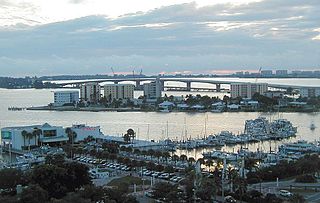
Sarasota is a city in Sarasota County on the southwestern coast of the U.S. state of Florida. The area is renowned for its cultural and environmental amenities, beaches, resorts, and the Sarasota School of Architecture. The city is at the southern end of the Tampa Bay Area, north of Fort Myers and Punta Gorda. Its official limits include Sarasota Bay and several barrier islands between the bay and the Gulf of Mexico. According to the U.S. Census Bureau, in 2018 Sarasota had a population of 57,738. In 1986 it became designated as a certified local government. Sarasota is a principal city of the Sarasota metropolitan area, and is the seat of Sarasota County.

Paul Marvin Rudolph was an American architect and the chair of Yale University's Department of Architecture for six years, known for his use of concrete and highly complex floor plans. His most famous work is the Yale Art and Architecture Building, a spatially complex brutalist concrete structure.

Mid-century modern (MCM) is the design movement in interior, product, graphic design, architecture, and urban development that became popular after WWII in 1945 and continued until the late 1970s. The term, employed as a style descriptor as early as the mid-1950s, was reaffirmed in 1983 by Cara Greenberg in the title of her book, Mid-Century Modern: Furniture of the 1950s, celebrating the style that is now recognized by scholars and museums worldwide as a significant design movement.

Mediterranean Revival is a design style introduced in the United States in the waning nineteenth century variously incorporating references from Spanish Renaissance, Spanish Colonial, Beaux-Arts, Italian Renaissance, Arabic Andalusian architecture, and Venetian Gothic architecture.
Gene Leedy was an architect based in Winter Haven, Florida. Leedy was one of the pioneers of the modern movement in Florida and later one of the founders of the Sarasota School of Architecture, whose members also included Paul Rudolph, Victor Lundy and others. After beginning his career in Sarasota, Leedy moved his practice to Winter Haven, Florida in 1954. Leedy is most well known for his bold use of precast concrete, especially long-span "double-tee" structural elements.

The Sarasota School of Architecture, sometimes called Sarasota Modern, is a regional style of post-war modern architecture that emerged on Florida's Central West Coast, in and around the city of Sarasota, Florida. It is characterized by open-plan structures, often with large planes of glass to facilitate natural illumination and ventilation, that address the unique indigenous requirements of the regional climate. Many of the architects who pioneered this style became world-renowned later in their careers, and several significant buildings remain in Sarasota today.

The Florida State University College of Fine Arts, located in Tallahassee, Florida, is one of sixteen colleges comprising the Florida State University (FSU). The College is ranked among the leading fine arts programs within the state, with award-winning theatre, visual art, interior design, and dance departments. In 2016, the College was ranked #69 on a national list of fine arts programs by U.S. News & World Report.

The Sarasota Opera House is an historic theatre, now opera house, located at 61 North Pineapple Avenue in Sarasota, Florida. The vision of a local man and the first mayor of the town, A. B. Edwards. It originally opened on April 10, 1926 with an elaborate three-story entrance containing "eight shops on the ground floor, 12 offices on the second floor, and 12 furnished apartments on the third, while the theatre's auditorium contained an orchestral pipe organ. As noted on the Sarasota Opera's website, the Sarasota Herald Tribune hailed Edwards for "having admitted Sarasota into a fairyland of costly decoration, rich furnishings and never to be forgotten artistry."

The Revere Quality House is a house located in Siesta Key, Florida that was designed by architects Paul Rudolph and Ralph Twitchell. It is a breakthrough in twentieth-century residential architecture which blends elements of the International Style with site-sensitive design that is considered one of the notable examples of the Sarasota School of Architecture. The house represents a substantial advancement in how people should live within their environment, and established a new paradigm in tropical home construction.
Cecil Abraham Alexander, Jr. was an American architect, principally a designer of commercial architecture, best known for his work in Atlanta, Georgia. He worked with the firm FABRAP, which, in 1985, became Rosser FABRAP International and is now Rosser International. Together with other architects of the firm, he "shaped the skyline of Atlanta".
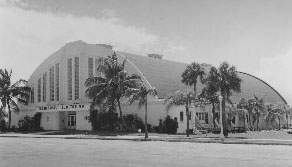
Thomas Reed Martin was an architect who was brought to Florida by one of its major developers during the turn of the twentieth century. He designed some 500 residences and various public and private buildings in Sarasota, as well as commercial buildings. His Florida buildings are located from Tampa to Fort Myers with many in Nokomis.
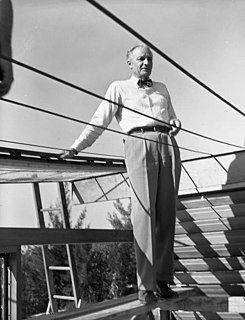
Ralph Spencer Twitchell was one of the founding members of the Sarasota School of Architecture. He is considered the father of the group of modernist architecture practitioners, that includes Paul Rudolph and Jack West, and other modernist architects who were active in the Sarasota area in the 1950s and 1960s like Ralph and William Zimmerman, Gene Leedy, Mark Hampton, Edward “Tim” Seibert, Victor Lundy, William Rupp, Bert Brosmith, Frank Folsom Smith, James Holiday, Joseph Farrell and Carl Abbott. He bridged the more traditional architecture of his early work in Florida during the 1920s with his modernist designs that began in the 1940s.

William J. Rupp was one of the modernist American architects considered part the Sarasota School of Architecture.

The architecture of Jacksonville is a combination of historic and modern styles reflecting the city's early position as a regional center of business. According to the National Trust for Historic Preservation, there are more buildings built before 1967 in Jacksonville than any other city in Florida, but it is also important to note that few structures in the city center predate the Great Fire of 1901. Numerous buildings in the city have held state height records, dating as far back as 1902, and last holding a record in 1981.
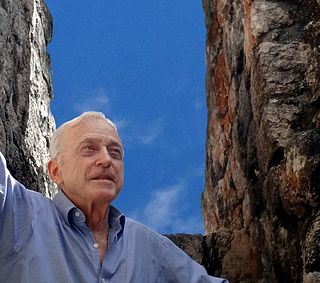
Carl Abbott is a Fellow of the American Institute of Architects and the youngest member of the original Sarasota School of Architecture.
Guy Wesley Peterson is an American architect based in Sarasota, Florida. Peterson is a Fellow of the American Institute of Architects and the recipient of the AIA Florida Gold Medal for his outstanding contributions to architecture. He has designed more than 200 structures in southwest Florida, including notable private and public works. Peterson is an adjunct professor of architecture at the University of Florida College of Design, Construction and Planning, and the author of Naked: The Architecture of Guy Peterson.
Edward John "Tim" Seibert was an architect based in Sarasota, Florida. Seibert was a Fellow of the American Institute of Architects and one of the founders of the modern movement known as the Sarasota School of Architecture.
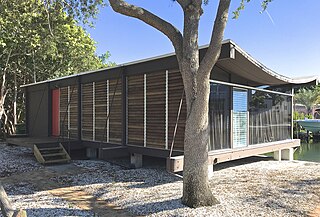
The Healy Guest House is a small guest cottage located in Siesta Key, Florida, originally built for Mr. and Mrs. W. R. Healy. It was designed in 1948 by Paul Rudolph and Ralph Twitchell during their five-year partnership that sparked a modern architecture movement in Florida; the Sarasota School of Architecture. Its radical shape, featuring an inverted catenary roof, was an experiment in structure and technology. It is considered one of the most significant architectural works of the twentieth-century.

Lamolithic house was the term given by Sarasota concrete businessman John Lambie to describe his unique method of building modern reinforced concrete residential structures. This building technique enabled the fabrication of thin ceiling and wall planes, thus enabling architects to draft efficient and lightweight designs. Several historic lamolithic houses were constructed by renowned architects Paul Rudolph and Ralph Twitchell on Siesta Key, Florida using this technique. These homes were among the earliest examples of reinforced concrete residential construction.

The Hiss Residence is a mid-century modern home designed by architect, Paul Rudolph. Built as a speculative concept home in 1953, the structure blends international style modernism with indigenous tropical design. It is among the preeminent works of the Sarasota School of Architecture and considered “one of the most remarkable homes of the twentieth century.”
References
- ↑ Harold Bubil (May 6, 2006). ""Florida Modern" – A Q&A With Jan Hochstim".
- ↑ Steven Moffson and Stephanie Cherry (February 2010). "National Register of Historic Places Registration: Cecil and Hermione Alexander House" (PDF). National Park Service . Retrieved 2010-04-03. (47 pages, with figures and 16 photos)